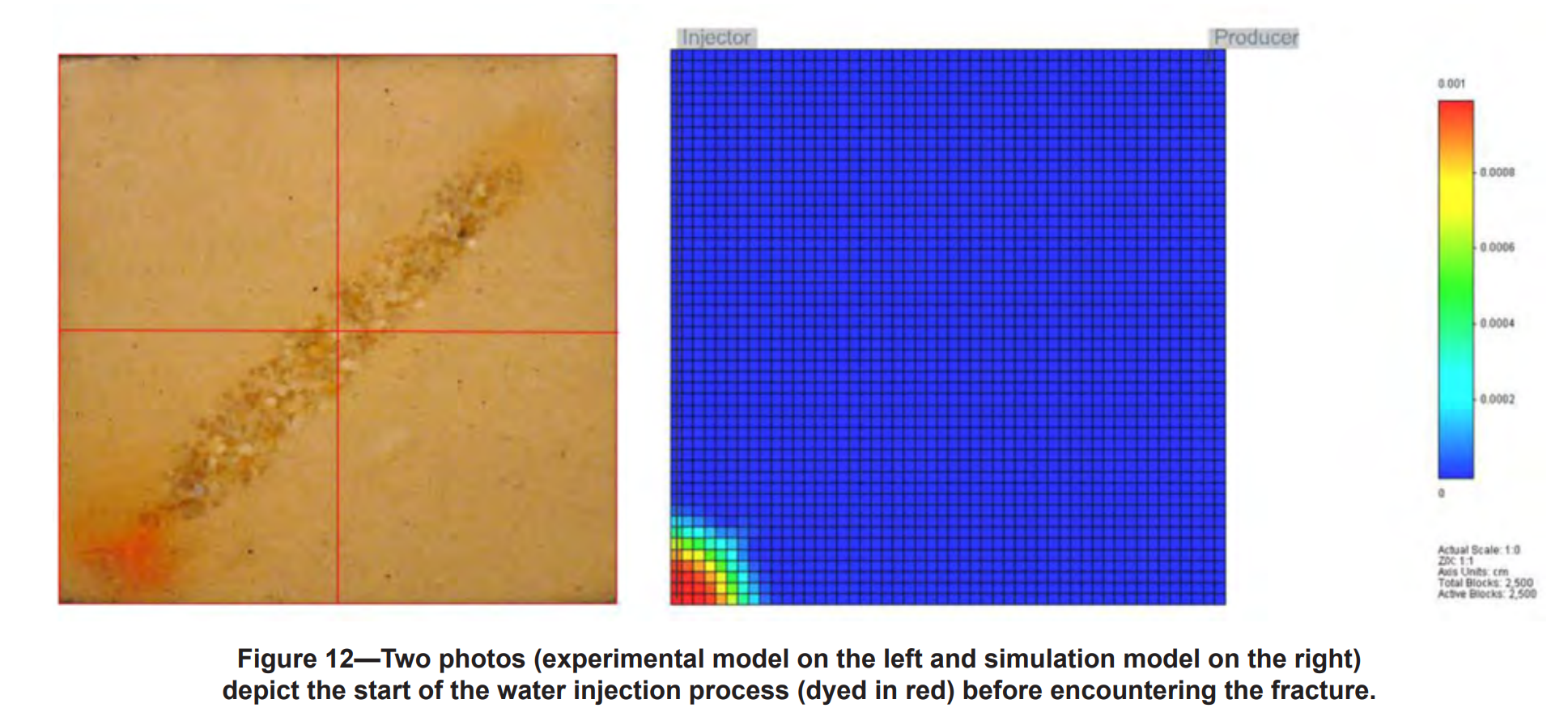An Experimental and Numerical Approach for the Best Enhanced Oil Recovery Strategy in Capillary-Dominant Reservoirs
天然裂缝储层(NFR)研究是具有挑战性的工作。对储层驱油机理认识不足,会导致严重的水窜问题。因此,本文通过数值模拟方法验证了非均质储层,特别是毛细管优势储层的基本流动机制,以研究该特定情况下的最佳EOR策略。
设计、制作有注入端和生产端的二维实验室尺度油藏模型,并在单相和两相流情况下进行水湿裂缝系统模拟实验。首先,研究单相流注水基础方案,并与文献进行比较,通过商业油藏模拟软件(CMG)进行了验证,最终考虑在控制变量有限的模拟模型中调整孔隙度和渗透率。在此基础上,按相同的程序进行了多次注水和聚合物驱油重复实验和模拟验证。
单相研究有助于区分水驱和聚合物驱方案。当注入到裂缝性水湿储层时,水倾向于通过高渗透优势通道,并产生体积扫掠差和明显的旁通带。当两相流中的控制变量增加时,毛细作用和流度比在模拟中占主导地位。注水过程中,由于基质和裂缝介质之间的毛细作用对比强,观察到流向基质介质的流动发散更快,超过了裂缝中的高渗透率前缘。即使存在强大的毛细现象,聚合物驱在所有情况下都表现出更好的体积驱替效率。
二维实验室尺度储层实验模型以及数值模拟是研究流体流动的最直观方法,展示了独特的提高采收率方式在裂缝性储层中的有效性。此外,实验首次证明了储层介质中小孔隙比大孔隙更具毛细优势。了解储层特征并掌握实施最佳开发方式的要点可以最大限度地延长油田的生命周期并提高采收率(RF)。
Abstract
Working with naturally fractured reservoirs (NFRs) can be challenging. Inadequate understanding of the enhanced oil recovery (EOR) driving forces in these reservoirs may result in serious conformance issues due to excessive water production. As a result, this work investigates and numerically validates some fundamental flow mechanisms in heterogeneous reservoirs, particularly capillary-dominant ones, to highlight the best EOR strategy for this specific case.
Consequently, a two-dimensional lab-scale reservoir model with injection and production ports was designed, fabricated, and tested in single-phase and two-phase flow scenarios, simulating a water-wet fractured system. First, a single-phase flow waterflood baseline was studied, compared to the literature, verified by commercial reservoir simulation software, and eventually considered to calibrate the porosity and permeability model in the simulation model where the controlling variables are limited. Based on this work, the same procedures were experimentally repeated and verified by simulation, where waterflooding and polymer injection were used to displace oil with more governing variables.
The single-phase scenarios aided in distinguishing between the waterflood and polymer flood cases. Water prefers to channel through high permeable streaks when injected into a fractured water-wet reservoir, resulting in poor volumetric sweep and significant bypassed zones. Whereas the controlling variables in two-phase flow were increased, capillarity and mobility ratio were dominant in the simulation. During waterflooding, flow divergence was observed faster toward the matrix medium, overriding the high permeability front in the fracture due to the strong capillarity contrast between the matrix and fracture media. Even when capillarity is strongly present, polymer flooding demonstrated a better volumetric sweep in all scenarios.
The unique demonstration of fluid flow inside the two-dimensional lab-scale reservoir model, as well as numerical simulation, shed light on the efficacy of these EOR strategies in fractured reservoirs. Furthermore, for the first time, the behavior of capillary-dominant reservoirs with an advancing flow path within smaller pores compared to larger ones within the reservoir media has been experimentally captured. Understanding reservoir characteristics and having the know-how to implement the best recovery scenario can, in fact, maximize the field’s life cycle and increase the Recovery Factor (RF).





一条评论